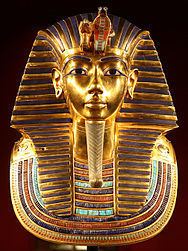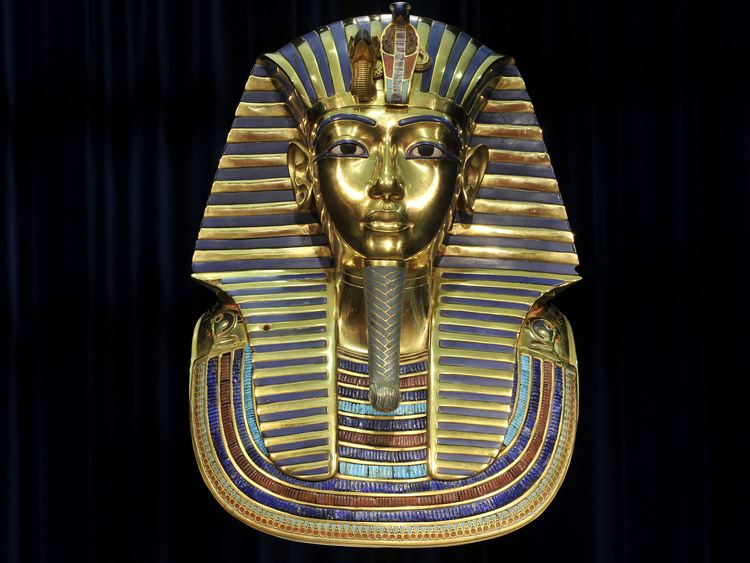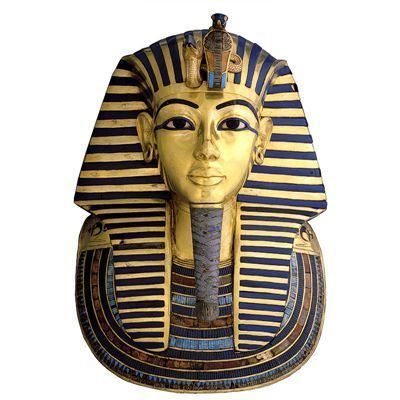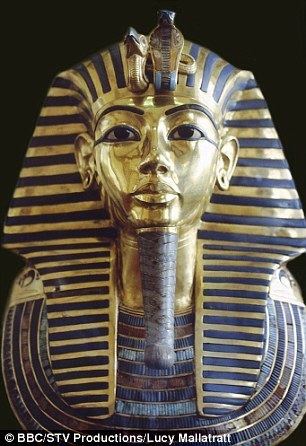Material Gold Created c.. 1323 BC Present location Egyptian Museum, Cairo | Size 54 × 39.3 × 49 cm Discovered 28 October 1925 | |
 | ||
Writing Ancient Egyptian hieroglyphs Similar Nefertiti Bust, The Seated Scribe, Narmer Palette, Tríada de Micerino, Great Sphinx of Giza | ||
Tutankhamun's mask, is funerary mask of Tutankhamun, is the death mask of the 18th-dynasty Ancient Egyptian Pharaoh Tutankhamun (reigned 1332–1323 BC). It was discovered by Howard Carter in 1925 in tomb KV62 and is now housed in the Egyptian Museum in Cairo. The mask is one of the most well known works of art in the world.
Contents

According to the Egyptologist Nicholas Reeves, the mask is "not only the quintessential image from Tutankhamun's tomb, it is perhaps the best-known object from ancient Egypt itself". Since 2001, research has suggested that it may originally have been intended for Queen Neferneferuaten; her royal name (Ankhkheperure) was found in a partly erased cartouche on the inside of the mask.

Discovery

Tutankhamun's burial chamber was found in the Valley of the Kings in the Theban Necropolis in 1922 and opened 3 years later. It would be another two years before the excavation team, led by the English archaeologist Howard Carter, was able to open the heavy sarcophagus containing Tutankhamun's mummy. On 28 October 1925, they opened the innermost of three coffins to reveal the gold mask, seen by people for the first time in approximately 3,250 years. Carter wrote in his diary:

The pins removed, the lid was raised. The penultimate scene was disclosed – a very neatly wrapped mummy of the young king, with golden mask of sad but tranquil expression, symbolizing Osiris … the mask bears that god's attributes, but the likeness is that of Tut.Ankh.Amen – placid and beautiful, with the same features as we find upon his statues and coffins. The mask has fallen slightly back, thus its gaze is straight up to the heavens.

In December 1925, the mask was removed from the tomb, placed in a crate and transported 635 kilometres (395 mi) to the Egyptian Museum in Cairo, where it is on public display.
Description
The mask is 54 cm (21 in) tall, 39.3 cm (15.5 in) wide and 49 cm (19 in) deep. It is fashioned from two layers of high-karat gold, varying from 1.5–3 mm (0.059–0.118 in) in thickness, and weighing 10.23 kg (22.6 lb). X-ray crystallography has revealed that the mask contains two alloys of gold: a lighter 18.4 karat shade for the face and neck, and 22.5 karat gold for the rest of the mask.
The face represents the pharaoh's standard image, and the same image was found by excavators elsewhere in the tomb, in particular in the guardian statues. He wears a nemes headcloth, topped by the royal insignia of a cobra (Wadjet) and vulture (Nekhbet), symbolising Tutankhamun's rule of both Upper and Lower Egypt. The ears are pierced to hold earrings, a feature that appears to have been reserved for queens and children in almost all surviving ancient Egyptian works of art.
It contains inlays of coloured glass and gemstones, including lapis lazuli (the eye surrounds and eyebrows), quartz (the eyes), obsidian (the pupils), carnelian, feldspar, turquoise, amazonite, faience and other stones (as inlays of the broad collar).
Beard
When it was discovered in 1925, the 2.5 kg (5.5 lb) narrow gold beard, inlaid with blue lapis lazuli to give it a plaited effect, had become separated from the mask, but it was reattached to the chin using a wooden dowel in 1944.
In August 2014, the beard fell off when the mask was taken out of its display case for cleaning. The museum workers responsible used quick-drying epoxy in an attempt to fix it, leaving the beard off-centre. The damage was noticed in January 2015, and has been repaired by a German-Egyptian team who reattached it using beeswax, a natural material used by the ancient Egyptians.
In January 2016, it was announced that eight employees of the Egyptian Museum were to stand trial for allegedly ignoring scientific and professional methods of restoration and causing permanent damage to the mask. A former director of the museum and a former director of restoration were among those facing prosecution.
Inscription
A protective spell is inscribed with Egyptian hieroglyphs on the back and shoulders in ten vertical and two horizontal lines. The inscription is from Chapter 151 of the Book of the Dead and first appeared on masks in the Middle Kingdom, 500 years before Tutankhamun.
Your right eye is the night bark [of the sun-god], your left eye is the day bark, your eyebrows are [those of] the Ennead of the Gods, your forehead is [that of] Anubis, the nape of your neck is [that of] Horus, your locks of hair are [those of] Ptah-Soker. [You are] in front of the Osiris [Tutankhamun], he sees thanks to you, you guide him to the goodly ways, you smite for him the confederates of Seth so that he may overthrow your enemies before the Ennead of the Gods in the great Castle of the Prince, which is in Heliopolis...the Osiris, the king of Upper Egypt Nebkheperura, deceased, given life like Ra.
Osiris was the Egyptian god of the afterlife.
Bead necklace
Although it is usually removed when the mask is on display, it has a triple-string necklace of gold and blue faience disc-beads with lotus flower terminals and uraeus clasps.
